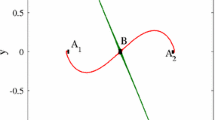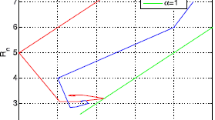Abstract
The transient and steady-state membership distribution functions (MDFs) of fuzzy response of a forced Duffing oscillator with fuzzy uncertainty are studied by means of the Fuzzy Generalized Cell Mapping (FGCM) method. The FGCM method is first introduced. A rigorous mathematical foundation of the FGCM is established with a discrete representation of the fuzzy master equation for the possibility transition of continuous fuzzy processes. The FGCM offers a very effective approach for solutions to the fuzzy master equation based on the min-max operator of fuzzy logic. Fuzzy response is characterized by its topology in the state space and its possibility measure of MDFs. The response topology is obtained based on the qualitative analysis of the FGCM involving the Boolean operation of 0 and 1. The evolutionary process of transient and steady-state MDFs is determined by the quantitative analysis of the FGCM with the min-max calculations. It is found that the evolutionary orientation of MDFs is in accordance with invariant manifolds leading to invariant sets. In the evolutionary process of a steady-state fuzzy response with an increase of the intensity of fuzzy noise, a merging bifurcation is observed in a sudden change of the MDFs from two sharp peaks of most possibility to one peak band around unstable manifolds.
Access this chapter
Tax calculation will be finalised at checkout
Purchases are for personal use only
Preview
Unable to display preview. Download preview PDF.
Similar content being viewed by others
References
Buckley, J.J., Feuring, T.: Fuzzy differential equations. Fuzzy Sets and Systems 110, 43–54 (2000)
Park, J.Y., Han, H.K.: Fuzzy differential equations. Fuzzy Sets and Systems 110, 69–77 (2000)
Yoshida, Y.: A continuous-time dynamic fuzzy system (I) A limit theorem. Fuzzy Sets and Systems 113, 453–460 (2000)
Buckley, J.J., Hayashi, Y.: Applications of fuzzy chaos to fuzzy simulation. Fuzzy Sets and Systems 99, 151–157 (1998)
Friedman, Y., Sandler, U.: Evolution of systems under fuzzy dynamic laws. Fuzzy Sets and Systems 84, 61–74 (1996)
Friedman, Y., Sandler, U.: Fuzzy dynamics as an altemative to statistical mechanics. Fuzzy Sets and Systems 106, 61–74 (1999)
Lin, Y.K., Cai, G.Q.: Probabilistic Structural Dynamics: Advanced Theory and Applications. McGraw-Hill, New York (1995)
Nazaroff, G.J.: Fuzzy topological polysystems. J. Math. Anal. Appl. 41, 478–485 (1973)
Kloeden, P.E.: Fuzzy dynamcal systems. Fuzzy Sets and Systems 7, 275–296 (1982)
Aubin, J.P.: Fuzzy differential inclusions. Problems of Control and Information Theory 19, 55–67 (1990)
Kaleva, O.: The cauchy problem for fuzzy differential equations. Fuzzy Sets and Systems 35, 389–396 (1990)
Ma, M., Friedman, M., Kandel, A.: Numerical solutions of fuzzy differential equations. Fuzzy Sets and Systems 105, 133–138 (1999)
Zhang, Y., Qiao, Z., Wang, G.: Solving processes for a system of first-order fuzzy differential equations. Fuzzy Sets and Systems 95, 333–347 (1998)
Chen, Y.Y., Tsao, T.C.: New approach for the global analysis of fuzzy dynamical systems. In: Proceedings of the 27th IEEE Conference on Decision and Control, Austin, Texas, USA, pp. 1415–1420 (1988)
Chen, Y.Y., Tsao, T.C.: Description of the dynamical behavior of fuzzy systems. IEEE Transactions on Systems, Man and Cybernetics 19(4), 745–755 (1989)
Smith, S.M., Comer, D.J.: Self-tuning of a fuzzy logic controller using a cell state space algorithm. In: Proceedings of the IEEE International Conference on Systems, Man and Cybernetics, vol. 6, pp. 445–450 (1990)
Song, F., Smith, S.M., Rizk, C.G.: Optimized fuzzy logic controller design for 4D systems using cell state space technique with reduced mapping error. In: Proceedings of the IEEE International Fuzzy Systems Conference, Seoul, South Korea, vol. 2, pp. 691–696 (1999)
Hsu, C.S.: Cell-to-Cell Mapping: A Method of Global Analysis for Non-linear Systems. Springer, New York (1987)
Edwards, D., Choi, H.T.: Use of fuzzy logic to calculate the statistical properties of strange attractors in chaotic systems. Fuzzy Sets and Systems 88(2), 205–217 (1997)
Sun, J.Q., Hsu, C.S.: Global analysis of nonlinear dynamical systems with fuzzy uncertainties by the cell mapping method. Computer Methods in Applied Mechanics and Engineering 83(2), 109–120 (1990)
Sun, J.Q., Hsu, C.S.: The generalized cell mapping method in nonlinear random vibration based upon short-time Gaussian approximation. Journal of Applied Mechanics 57, 1018–1025 (1990)
Crespo, L.G., Sun, J.Q.: Stochastic optimal control of nonlinear dynamic systems via bellman’s principle and cell mapping. Automatica 39(12), 2109–2114 (2003)
Hong, L., Xu, J.X.: Crises and chaotic transients studied by the generalized cell mapping digraph method. Physics Letters A 262, 361–375 (1999)
Hong, L., Xu, J.X.: Discontinuous bifurcations of chaotic attractors in forced oscillators by generalized cell mapping digraph (GCMD) method. International Journal of Bifurcation and Chaos 11, 723–736 (2001)
Hong, L., Sun, J.Q.: Bifurcations of fuzzy nonlinear dynamical systems. Communications in Nonlinear Science and Numerical Simulation 11(1), 1–12 (2006)
Hong, L., Sun, J.Q.: Codimension two bifurcations of nonlinear systems driven by fuzzy noise. Physica D-Nonlinear Phenomena 213(2), 181–189 (2006)
Hsu, C.S.: Global analysis of dynamical systems using posets and digraphs. International Journal of Bifurcation and Chaos 5(4), 1085–1118 (1995)
Jiang, J., Xu, J.X.: A method of point mapping under cell reference for global analysis of nonlinear dynamical systems. Phys. Lett. A 188, 137–145 (1994)
Jiang, J.: An effective numerical procedure to determine saddle-type unstable invariant limit sets in nonlinear systems. Chin. Phys. Lett. 29(5), 050503 (2012)
Author information
Authors and Affiliations
Corresponding author
Editor information
Editors and Affiliations
Rights and permissions
Copyright information
© 2014 Springer International Publishing Switzerland
About this paper
Cite this paper
Hong, L., Jiang, J., Sun, JQ. (2014). Response Analysis of a Forced Duffing Oscillator with Fuzzy Uncertainty. In: Tantar, AA., et al. EVOLVE - A Bridge between Probability, Set Oriented Numerics, and Evolutionary Computation V. Advances in Intelligent Systems and Computing, vol 288. Springer, Cham. https://doi.org/10.1007/978-3-319-07494-8_1
Download citation
DOI: https://doi.org/10.1007/978-3-319-07494-8_1
Publisher Name: Springer, Cham
Print ISBN: 978-3-319-07493-1
Online ISBN: 978-3-319-07494-8
eBook Packages: EngineeringEngineering (R0)




